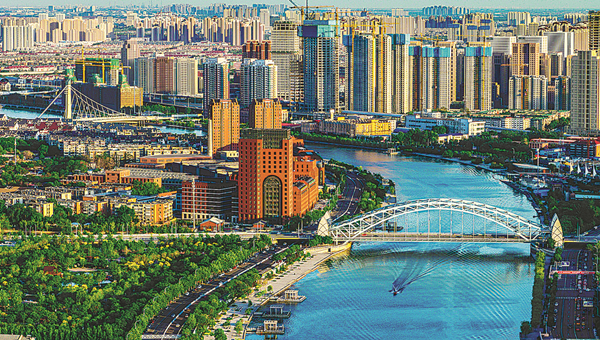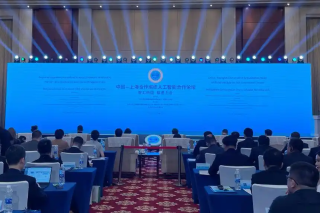New block aiming to raise Tianjin's art cachet

An aerial photo showing the Cotton 3 Creative Blocks, an emerging creative cultural area with a concentration of art organizations, artists and firms, in Tianjin. [Photo for China Daily]
The Haihe Art Museum in Tianjin, which opened to the public late last year, is looking to become a new city landmark and an international cross-disciplinary arts center.
Its first show exhibited pieces by a number of leading painters from the international arts circle.
Li Liangjie, a folk art performer and a household name in Tianjin, recently moved his studio closer to the museum. He said he hopes to benefit from the concentration of creative artists, firms and training institutions the area is attracting.
Both the museum and Li's studio are located in the Tianjin Cotton 3 Creative Blocks on the eastern shore of the Haihe River in the city's Hedong district. It was a cotton mill in the early 1920s before becoming a State-owned factory in the 1950s and covers an area of over 100,000 square meters.
Hedong has played a key role in Tianjin's industrial history. In the 1920s, Peking Opera master Mei Lanfang (1894-1961) was one of the investors in the area, which was conceived during the country's efforts to rescue its sluggish economy.
In recent years, the blocks, which resemble Beijing's 798 Art Area, have emerged as a model for the reuse of industrial heritage by cultural and creative industries, as a result of their growing concentration of art organizations, firms and artists.
"Art infrastructure has become an indispensable cultural element of every city," said Chen Qiang, general manager of Management and Service for the Cotton 3 Creative Blocks, "and its professionalism and visibility have become an important indicator of a city's, even a country's cultural development, as well as a representation of an accumulation of history."
Similarly, in Shanghai's Yangpu district, the government is transforming Binjiang South Road, a former industrial cluster, into a multidimensional arts district.
Like Cotton 3, Yangpu has many old industrial buildings and plenty of industrial equipment on display. With its combination of 20th century industrial style and contemporary arts, Binjiang South Road has created a vibrant style of culture and life.
"I was born and raised in Yangpu and was involved in its transformation. It is amazing to witness cultural nostalgia being combined with the energy of modern arts," Xu Jin, chief engineer of the planning department at the Shanghai Yangpu Binjiang Investment Development Company, told Guangming Daily.
Since the 1990s, China has been promoting industrial transformation and upgrading. After many companies began to relocate to more remote areas, ways to reuse industrial heritage became an urban development priority.
Last year, multiple government authorities published a joint plan for boosting the protection and reuse of urban industrial heritage, inspiring the exploration and transformation of old industrial areas. In addition, the Ministry of Housing and Urban-Rural Development announced the first batch of urban renewal projects in 21 cities and districts, with the goal of upgrading existing buildings with a focus on preserving their history.
Industrial heritage faces pressure from economic development as the trend for giving old cities a face-lift continues. Many researchers and city planners are trying to find a solution that respects both economic development and industrial heritage conservation.
Xu Subin, professor and deputy director of the China Cultural Heritage Protection International Research Center at Tianjin University, said that art clusters in Tianjin and Shanghai are vivid examples of their attempts to transform themselves into creative art cities.
In 2004, UNESCO set up the Creative Cities Network, which seeks to promote exchanges between member cities and the development of local cultural and industrial heritage to support cultural diversity under globalization.
According to UNESCO's International Center for Creativity and Sustainable Development, 14 Chinese cities have joined the network, the largest number of cities from one country to do so among network member states. Participants include Shenzhen in Guangdong province, Suzhou in Jiangsu province and Qingdao in Shandong province.
Xu noted that under globalization, industrial transfer and upgrade is being driven by the growth of creative industries and that creative cities are the new urban development model.
"From industrial cities to creative cities, industrial heritage's fabulous transformation is expected to contribute great value to a city's sustainable development," Xu noted.

Copyright ©
Tianjin Municipal Government. All rights reserved. Presented by China Daily.
京ICP备13028878号-35



